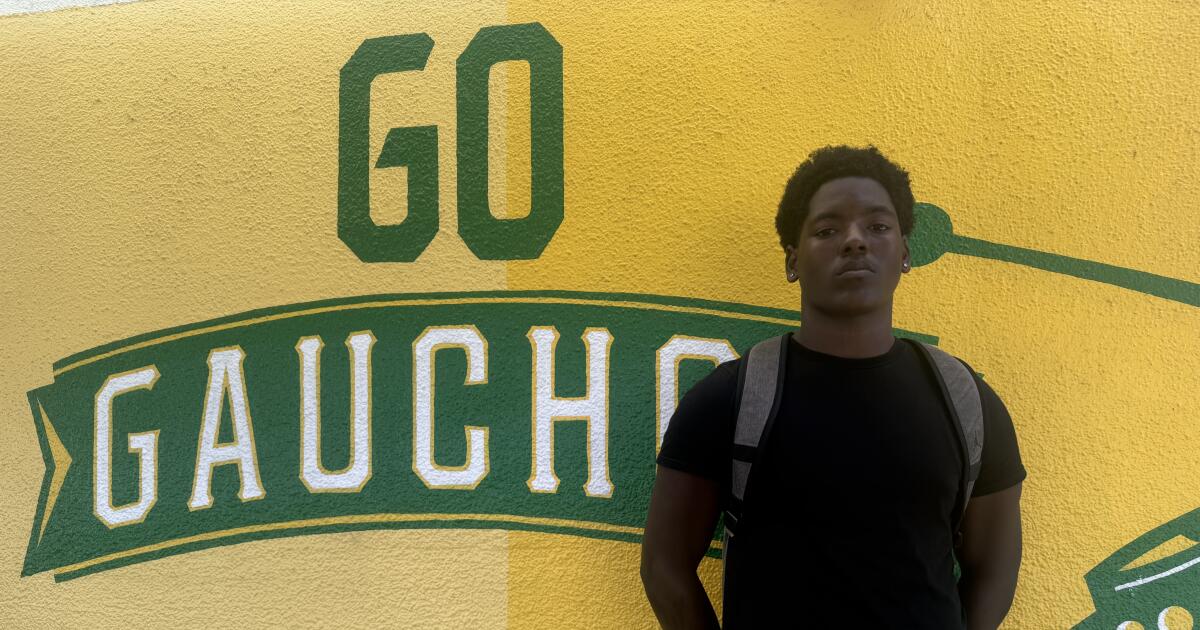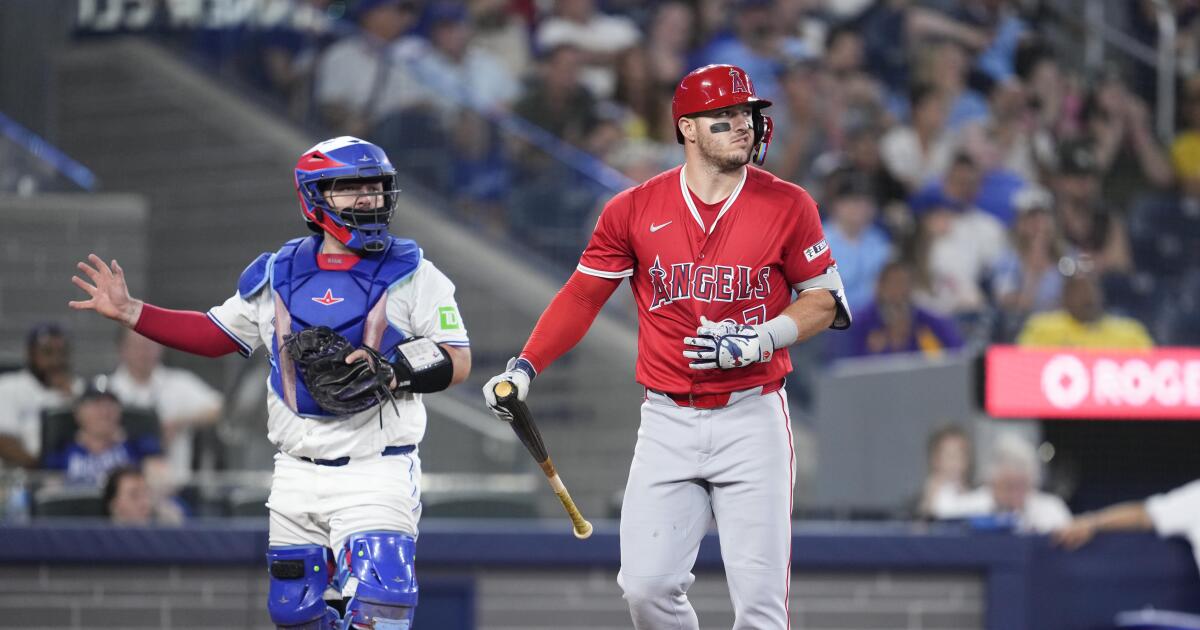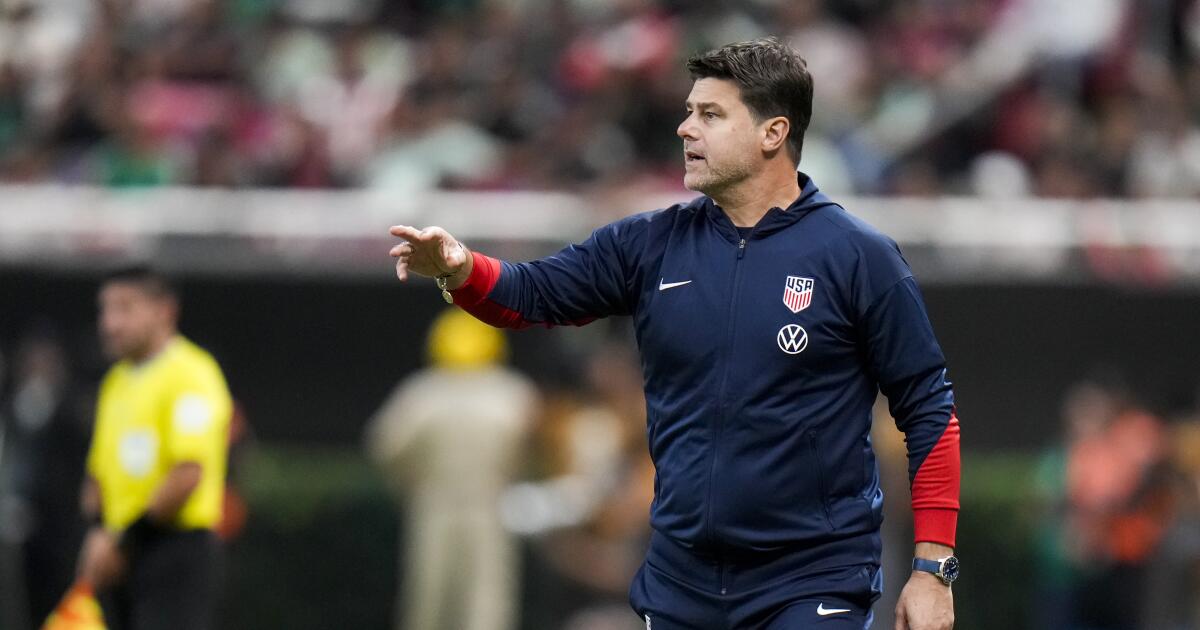King’leon Sheard leading the way during another Narbonne rebuild
There was a large trash can obstructing the view of a Narbonne Gaucho sign on the gym wall, so King’leon Sheard simply picked up the container and moved it out of the way in an impressive display of strength like a WWE wrestler flicking away an annoying opponent.
At 6 feet 2 and 220 pounds, Sheard had two sacks in last year’s City Section Open Division championship football game against San Pedro. On Friday night, he had two sacks in Narbonne’s 42-6 loss to Los Osos. The fact he’s still walking around Narbonne’s campus in his senior year is a story itself.
After the program was placed on probation and banned from the playoffs for three years for rules violations, there was an exodus of players and coaches. This also happened after the 2019 season when Narbonne was punished for similar circumstances — an ineligible player.
“Now it’s been two rebuilds since I’ve been here,” he said, remembering a 2-9 season in 2022 when he arrived as a freshman.
Sheard is either a glutton for punishment or determined to prove his worth no matter how many times Narbonne has to start over.
“At the root of it, it’s not just about football,” the outside linebacker said. “I made a lot of connections here. I built a nice family here. At the end of the day, it was more about my story, not what everyone else was doing. I always knew I could prevail.”
Football is what Sheard wants to do in college if he gets a chance. Yet academics has been his focus, with a dream of becoming a lawyer.
“I want to go into law,” he said. “It’s always been one of those things I’ve been interested in since I can remember.”
Sheard clearly knows how to investigate facts and make a judgment call. That’s what he did in deciding to stay at Narbonne with four other holdovers.
“I kept my head down,” he said. “My parents stayed out of it. They knew if I stayed, I’d be able to make it. I started here and was going to finish here.”
Not that Sheard didn’t consider leaving. He said he discussed leaving with several coaches. Their big selling point was having a postseason. But Sherard is guaranteed more games this season without playoffs (10) than he had all last season (eight) because of a coaches’ boycott during league play.
“I will admit I had conversations with other coaches when I heard the news that our coaches wouldn’t be with us,” he said. said. “The main talking point was, ‘We have playoffs, we have playoffs.’ You lose one game in the playoffs, you’re out anyways. I was more concerned how as coaches would you be able to help me make it to the collegiate level. How would you be able to develop me as a player.”
Enter Narbonne’s new coach, Doug Bledsoe, who’s been head coach at North Hollywood, Dorsey, Pasadena and L.A. University. Sheard placed his trust in Bledsoe and his staff.
“I formed a good relationship with coach Bledsoe and the position coaches,” he said.
Said Bledsoe: “He’s got real tenacity to get to the quarterback and a quick first step.”
Bledsoe is using a 3-4 defensive front with Sheard scheduled to be his “mini-Lawrence Taylor,” the NFL Hall of Fame linebacker known for sacking quarterbacks.
There could be tough times for the Gauchos, a team with little varsity experience and some tough early-season games.
Since this is his second rebuild he’s experienced, Sheard was asked how is it supposed to go?
“It’s not up to me,” he said. “Most I can do as a player is keep my brothers close to me and tell them, ‘It will be fine. We can do this.’”
With a new coach and new principal, perhaps Narbonne can rebuild the right way — following City Section rules. Good behavior could lead to a reduction in sanctions.
Clearly, it’s a big change because at this time last season, the Gauchos had 27 transfers in the program. This season the number is zero.
Sheard is just glad he can play four Marine League games this season so he’ll have film to show college recruiters. Last year’s league games were forfeits because schools refused to play the Gauchos.
“I felt a little slighted,” he said. “Outside of everything happening, I didn’t care. It was still my season. It was my opportunity to get stuff on film. I feel it was taken away and I had no control. I kept working.”
When it comes to gaining maturity and learning hard lessons, Sheard and his small group of fellow seniors who stayed are in for a challenging season with no playoffs allowed.
It’s a reminder of the line, “When the going gets tough, the tough get going.”
“Ten games are guaranteed,” he said. “Compared to last year, it’s a blessing.”




